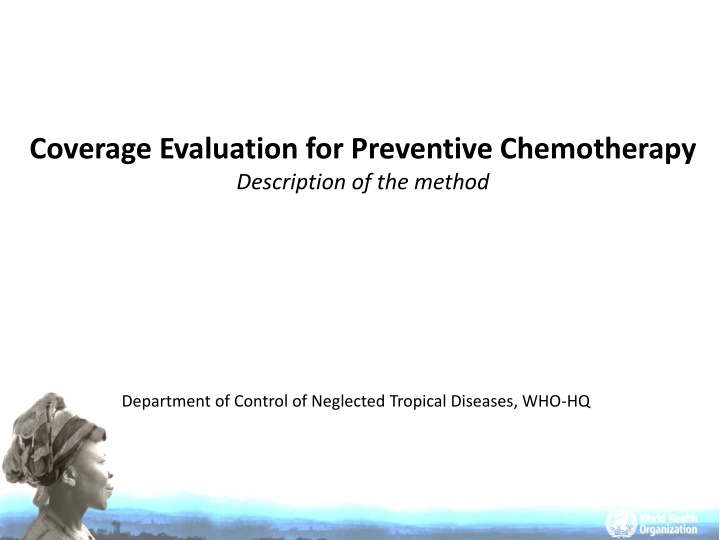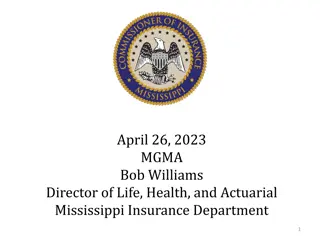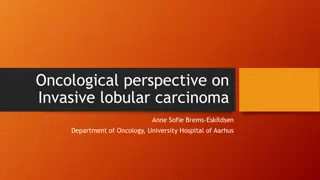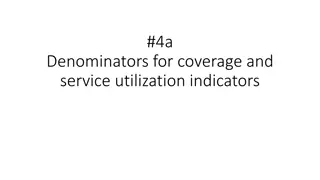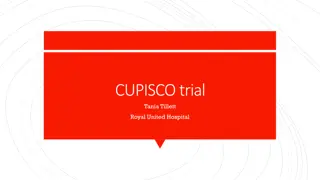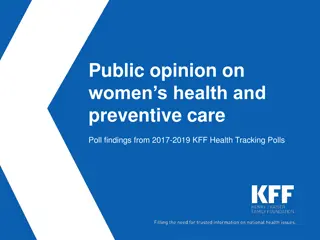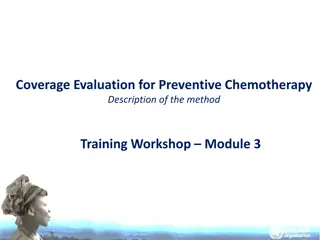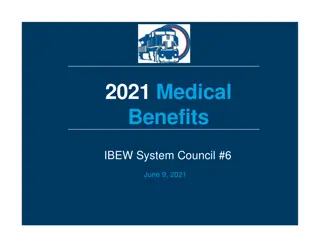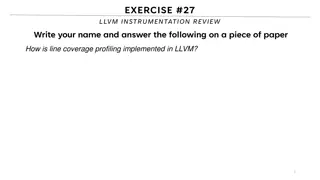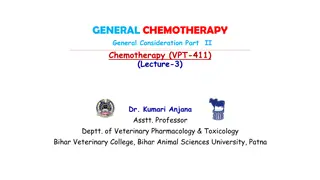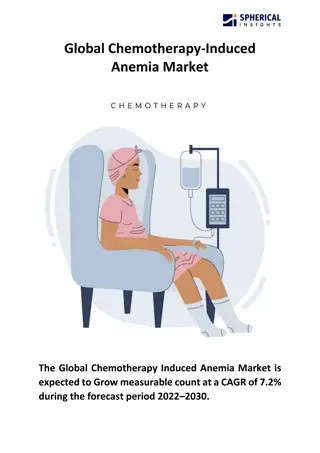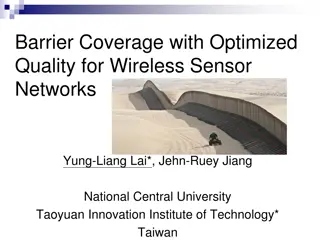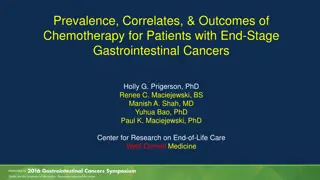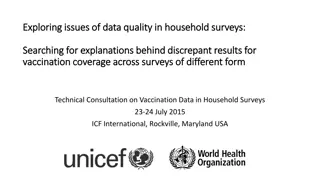Coverage Evaluation for Preventive Chemotherapy
Methods for evaluating treatment coverage in preventive chemotherapy for neglected tropical diseases (NTDs) are crucial for achieving disease control and elimination goals. Routine data can be unreliable due to various biases and errors, highlighting the importance of population-based surveys for precise coverage estimates. These evaluations help determine if target thresholds are met, validate reported coverage, identify non-compliance reasons, detect supply chain issues, and assess coverage in specific populations. Despite challenges such as limited resources and expertise, post-MDA coverage evaluations are vital but underutilized in NTD programs. Recognized methodologies, like the EPI cluster-survey method, offer practical and standardized approaches for conducting coverage evaluations.
Download Presentation

Please find below an Image/Link to download the presentation.
The content on the website is provided AS IS for your information and personal use only. It may not be sold, licensed, or shared on other websites without obtaining consent from the author.If you encounter any issues during the download, it is possible that the publisher has removed the file from their server.
You are allowed to download the files provided on this website for personal or commercial use, subject to the condition that they are used lawfully. All files are the property of their respective owners.
The content on the website is provided AS IS for your information and personal use only. It may not be sold, licensed, or shared on other websites without obtaining consent from the author.
E N D
Presentation Transcript
Coverage Evaluation for Preventive Chemotherapy Description of the method Department of Control of Neglected Tropical Diseases, WHO-HQ 1
Rationale: Background & Context Achieving uniformly high treatment coverage in every treatment round is critical for the attainment of established NTD disease control and elimination goals. monitoring treatment coverage using administrative / routinely reported data during mass drug administration (MDA) activities can be unreliable: Incomplete tallying or reporting poorly documented shifts in population reliance on outdated census data treatment of individuals outside the targeted age group or geographic area
Coverage Evaluation Definition: are population-based surveys that are designed to provide precise statistical estimates of coverage that overcome many of the biases and errors that can undermine routinely reported coverage. Objective: 1. To determine if the target coverage threshold has been met 2. To validate the reported coverage Justification for preventive chemotherapy: 1. Sustained high coverage crucial to elimination and control 2. Reported coverage often inaccurate 3. Coverage evaluation surveys can save programs time and money 4. MDA round with low/below target coverage is not effective
Uses for Coverage Evaluation for preventive chemotherapy 1. Estimation of PC coverage to obtain a precise estimate of PC coverage that can be compared with the target coverage threshold to determine if the MDA was effective. 2. Validation of reported coverage to check the accuracy of the data recording and reporting system and take corrective actions where necessary. 3. Identifying reasons for non-compliance by identifying common reasons for not swallowing the drugs, programme managers can improve social mobilization prior to the next MDA round. 4. Detecting problems with the supply chain and distribution systems can identify clusters of individuals for whom the drugs were never offered and corrective action can be taken 5. Measuring coverage in specific population: subpopulations, e.g.. Rural vs. urban
The NTD Experience 2002 - 2012 post-MDA coverage evaluations acknowledged as very important but seldom conducted: limited time and financial resources, poor accessibility of households, lack of available transportation Lack of M&E staff lack of expertise Etc. NTD programs to implement, produces valid point estimates of coverage, and can be standardized for use across the PC NTDs". Expert Consultation Meeting, 2012 " identify a coverage survey sampling methodology that is feasible for national
Review of methods When coverage evaluations are conducted, Expanded Programme on Immunization (EPI) cluster-survey method most common + Practicality + Simplicity + Widespread use - Falls short of probability sampling - Results in biased estimates - EPI program replacing method in favor of rigorous probability sampling Updating current methods to a standard approach for coverage evaluations that is statistically rigorous while feasible for programs to implement 6
Coverage Evaluation Common Methodologies: Overall Pros and Cons Lot Quality Assurance Sampling (LQAS) Probability Sampling with Segmentation (PSS) EPI cluster-survey Proven feasibility Precise Widely used Feasible Small sample size Classification of Survey Areas Pros Feasible Precise Unbiased Biased results EPI programme moving away from method Must visit at least 95 different villages Imprecise Cannot directly calculate coverage est. Requires HH weighting or individual enumeration to avoid HH-size bias Cons Segmentation can be time consuming when maps not available Difficult to segment large villages; EAs are much easier to use 7
Key features of coverage evaluation methods Probability Sampling with Segmentation (PSS) Lot Quality Assurance Sampling (LQAS) EPI cluster-survey Feasible Yes Yes Yes Unbiased No Depends/subjective Yes Clusters (EAs3) 30 95 30 15001 952 15001 Sample Size Precise Yes No Yes List of EAs & pop (optional) maps List of EAs & pop. 5 Supervisory Areas (optional) maps List of EAs & pop. (optional) maps Preparation 1Sample sizes will vary based on the parameters used, but typically range from 1,000 - 1,600 individuals 2Only one individual is selected per cluster, which is why the sample size and number of clusters are the same 3EAs = census Enumeration Areas
WHO/STAG NTD-WG M&E recommended: Probability sampling with segmentation (PSS) 1. Select 30 EAs using PPES Path Segment 1 Stream Road 2. Divide EA into segments of ~50 House Holds (HH) House School 3. Randomly select 1 segment 4. Walk through segment and sample houses systematically according to the sampling interval Segment 2 EA = census enumeration area PPES = probability proportional to estimated size HH = household
Main Difference Between EPI Method 1. Spin a bottle or pen in the center of village, then choose one random house between the center of the village and the edge of the village, in the direction of the spin, as the starting household 2. Visit nearest neighbor household, sampling all eligible within the household, until sample size is reached 10
Limitations: EPI Do all individuals in a village have an equal probability of selection? No, HH towards the center more likely to be selected. 11
Limitations: EPI Do individuals in different clusters have the same probability of selection? No. The probability that an individual s village is selected is based on its estimatedsize (PPES) but within the selected village (cluster) the probability that an individual is chosen is based on the actual village size. 30 ????` ????` 60 ???? P(Individualij) = Estimated village size Actual village size ????` ????
Probability Sampling with Segmentation (PSS) Does everyone have an equal probability of selection? -YES P(individual) = ????????? ????????? 1 1 ? ? ????????? ? 1 ? = ????????? 13
Coverage Evaluation 3 methods common compared in 4 countries in 2015 1 3 PSS PSS 2 PSS LQAS PSS EPI EPI EPI LQAS EPI LQAS LQAS Same district & team for each method Different district & team for each method 15
A comparison of surveyed vs. reported coverage 100% Some surveys exceed the target coverage threshold, while others fail. 90% Target threshold (LF, STH) 80% 70% 60% Coverage 50% 40% 30% 20% 10% 0% EPI LQAS PSS EPI LQAS PSS PSS - ALBPSS - IVMPSS - PZQ PSS - ZITH EPI - PreK EPI - HH LQAS - PreK LQAS - HH PSS - PreK PSS - HH Burkina Malawi Uganda Honduras Surveyed Coverage Reported Coverage 16
A comparison of surveyed vs. reported coverage 100% In 14 of the 16 surveys, reported coverage was greater than surveyed coverage. 90% 80% 70% 60% Coverage 50% 40% 30% 20% 10% 0% EPI LQAS PSS EPI LQAS PSS PSS - ALB PSS - IVM PSS - PZQ PSS - ZITH EPI - PreK EPI - HH LQAS - LQAS - HH PSS - PreK PSS - HH PreK Burkina Malawi Uganda Honduras Surveyed Coverage Reported Coverage 17
Comparative costs for Coverage Evaluation Surveys (2014 2015) EPI LQAS PSS Country Days to complete Days to complete Days to complete Cost Cost Cost Burkina 18 $ 4,385 19 $ 4,816 17 $ 4,525 $ 1,867a $ 1,167a $ 1,520a Honduras 22 9 18 Malawi 14 $ 4,113 10 $ 3,247 16 $ 4,546 Uganda 23 $ 4,040 21 $ 3,835 26 $ 4,535 AVERAGE 19.25 $ 3,601 14.75 $ 3,266 19.25 $ 3,782
Acknowledgement of Contributors MOH Burkina Faso Roland Bougma District health teams in Batie, Dano and Diebougou MOH Uganda Edridah Tukahebwa Harriet Lwanga (RTI Envision, Uganda) Survey teams from MOH MOH Malawi Square Mkwanda District health teams in Balaka, Zomba, and Machinga Secretary of Health Honduras Reina Teresa PAHO (Honduras & DC) Rosa Elena Mejia & Romeo Montoya Martha Saboya, Laura Catala- Pascual & Ana Morice Pamela Mbabazi (WHO) Michael Deming (formerly CDC) Kristen Renneker (NTD-SC) Abdel Direny (RTI Envision) Funding Bill & Melinda Gates Foundation USAID 19
M&E tools for improving quality of data reported by national NTD programmes implementing preventive chemotherapy Supervisor s Coverage Tool Coverage Evaluation Survey Data Quality Assessment To assess capacity of data management and reporting systems To improve performance during current MDA To validate reported coverage (obtain a statistical point estimate) Purpose: Administrative level: Supervision Area (sub-district) Implementation Unit (district) National and/or District Sample size: 20 people >500 people N/A Sites visited: 1 supervision area 30 villages 12 service delivery points Internal and external to programme After MDA data have been reported (3-6 months post-MDA) $ 12,000 15,000 nationally $1,000 2,500 per district Survey team: Internal, self-assessment External to programme Timing: Within 2 weeks of MDA Within 6 months of MDA Cost: $0 - $1,000 per SA ~$2,000 $10,000 per district Duration: <1 week 2-3 weeks ~ 2-3 weeks
